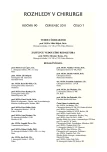The Spectrum of Diaphragmatic Injuries Managed in a Prague Traumatology Centre
Authors:
F. Vyhnánek; D. Jirava; P. Skála; V. Ducháč; O. Vojtíšek
Authors‘ workplace:
Traumatologické centrum, Chirurgická klinika FNKV a 3. LF UK, Praha
Published in:
Rozhl. Chir., 2011, roč. 90, č. 7, s. 377-381.
Category:
Monothematic special - Original
Overview
Introduction:
Diaphragmatic injuries may result from blunt or penetrating injuries. The symptomatology is usually overlaid by symptoms of associated abdominal or thoracic injuries or by symptoms of other systems injuries in polytraumas. Multidetector computer tomography (MDTC) facilitates the improvement of preoperative diagnostics in blunt injuries. The retrospective study included analysis of a study group of subjects with blunt and penetrating diaphragmatic injuries.
Patients, Methods and Results: From 1996 to 2009, a total of 44 injured patients with diaphragmatic injuries were operated in the FNKV (Faculty Hospital Kralovske Vinohrady) Traumatology Centre. The group included 17 blunt injuries and 27 penetrating injuries. There were 39 male and 5 female subjects, aged from 17 to 76 years. 32 subjects suffered from left-sided diaphragmatic injuries and 13 subjects from right-sided injuries. The commonest type of penetrating injuries were stab injuries in 21 subjects. 40 patients suffered from associated injuries. The commonest associated injuries included liver and splenic injuries. Simultaneous thoracotomy and laparotomy for associated injuries affecting the both cavities was performed in 21 patients. Left-sided diaphragmatic injury with associated abdominal injury was managed using laparotomy. Thoracoscopy or laparoscopy was used in 3 subjects with penetrating injuries.
Conclusion:
Penetrating injuries are the commonest cause of diaphragmatic injuries, with prevailing left-sided location of the injury. MDCT is an asset in the diagnostics of blunt diaphragmatic injuries. Surgical approach was selected based on the injury location and on the presence or absence of associated injuries. The miniinvasive approach contributes to the daignostics of penetrating diaphragmatic injuries in patients with stable hemodynamic conditions.
Key words:
blunt and penetrating diaphragmatic injury – diagnostics – treatment
Sources
1. Chughtai, T., Ali, S., Sharkey, P., Lins, M., Rizoli, S. Update on managing diaphragmatic rupture in blunt trauma: a review of 208 consecutive cases. Can. J. Surg., 2009; 52: 177–181.
2. Ozpolat, B., Kaya, O., Yazkan, R., Osmanoglu, G. Diaphragmatic injuries: a surgical challenge. Report of forty-one cases. Thorac. Cardiovasc. Surg., 2009; 57: 358–362
3. Scharff, J. R., Naunheim, K. S. Traumatic diaphragmatic injuries. Thorac. Surg. Clin., 2007; 17: 81–85.
4. Desser, T. S., Edwards, B., Hunt, S., Rosenberg, J., Purtill, M. A., Jeffrey, R. B. The dangling diaphragm sign: sensitivity and comparison with existing CT signs of blunt traumatic diaphragmatic rupture. Emerg. Radiol., 2010; 17: 37–44.
5. Tan, K. K., Yan, Z.Y., Vijayan, A., Chiu, M. T. Management of diaphragmatic rupture from blunt trauma. Singapore Med. J., 2009; 50: 1150–1153.
6. Clarke, D. L., Greatorex, B., Oosthuizen, G. V., Muckart, D. J. The spectrum of diaphragmatic injury in a busy metropolitan surgical service. Injury, 2009; 40: 932–937.
7. Hanna, W. C., Ferri, L. E. Acute traumatic diaphragmatic injury. Thorac. Surg. Clin., 2009; 19: 485–489.
8. Powell, B. S., Magnotti, L. J., Schroeppel, T., et al. Diagnostic laparoscopy for evaluation of occult diaphragmatic injury following penetrating thoracoabdominal trauma. Injury, 2008; 39: 530–534.
9. Bagheri, R., Tavassoli, A., Sadrizadeh, A., Marshhadl, M. R., Shahri, F., Shojaeian, R. The role of thoracoscopy for diagnosis of hoden diaphragmatic injuries in penetrating thoracoabdominal trauma. Interact Cardiovasc. Thorac. Surg., 2009; 9: 195–197.
10. Šimánek, V., Třeška, V., Klečka, J., Špidlen, V.,Vodička, J. Pozdně diagnostikovaná ruptura bránice – kazuistika. Rozhl. Chir., 2009; 88: 262–263.
11. Hájek, M. Traumatologie hrudníku, Praha, Avicenum, 1980.
Labels
Surgery Orthopaedics Trauma surgeryArticle was published in
Perspectives in Surgery

2011 Issue 7
Most read in this issue
- Antibiotic Prophylaxis in Acute Surgical Procedures – The Current Praxis in Czech Republic
- Arthritis Sternoclavicularis as a Cause of Mediastinitis
- Surgical Management of Perforations during Colonoscopy
- 750 Satisfied Patients? Stapled Haemorrhoidopexy (Longo Procedure) for the Treatment of Haemorrhoids and Anal Canal Prolapse: A Review of our 10-year Experience
